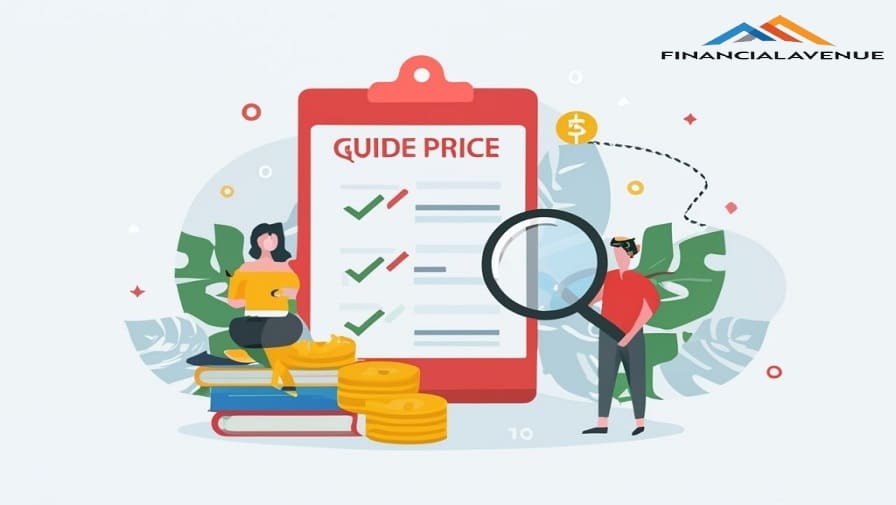A guide price is an estimated value or price range that a seller sets when putting an item up for sale, especially for high-value goods sold at auction like property, cars, art, and jewelry. It serves as a starting point for negotiations between buyers and sellers.
But what exactly does “guide price” mean, how does it work, and what should buyers and sellers keep in mind when seeing something listed with a guide price? This in-depth guide explains everything you need to know.
What is a Guide Price?
A guide price is a suggested price range that indicates what the final selling price could potentially be for an item at auction or online.
It sets buyer expectations and attracts appropriate interest by signaling what ballpark figure the seller expects based on current market conditions.
For example, a home with a guide price of £250,000 to £275,000 indicates:
- The seller hopes to get near £250,000 at minimum
- Bids near £275,000 are expected
- The eventual sale price will likely fall somewhere in that £50,000 range
A guide price is different from an:
- Asking price: A specific price that a seller requests for an item
- Reserve price: The minimum amount a seller will accept (often secret)
Read this article if you are wondering What Does GPC EFT Mean on a Bank Statement?
How Are Guide Prices Determined?
When selling an item, especially a high-value product like property, the seller will usually hire an expert like an auctioneer or estate agent to assess the current market and determine an appropriate guide price range.
Factors like location, condition, market demand, and recent sales prices for comparable items will all be analyzed to gauge market value. The range takes into account both seller expectations and what buyers may reasonably be willing to pay.
For example, to set a guide price for a home, an estate agent will research:
- Recent sale prices of similar nearby homes
- Number of days recently sold homes spent on the market
- Current buyer demand and competition in the area
This helps them advise the seller on a realistic pricing strategy to effectively market the property.
Are you worried about What Does “SQ” on My Bank Statement Mean? Then read this article.
When Are Guide Prices Used?
Some common situations when guide prices are utilized include:
- Property sales: Especially at auction, guide prices indicate value for homes, land, commercial real estate, etc.
- Car auctions: Guide prices let buyers assess condition and value of vehicles
- Art auctions: Ranges account for subjective nature of art appraisals
- Online auctions: Sites like eBay set guides for unique/rare items
- Jewelry auctions: Precious materials are appraised to determine guides
Essentially, guide prices are useful any time an intermediary like an auction house or agent is helping sell a high-value, unique item in a competitive environment.
Learn More about Average UK Salary by Area
The Pros and Cons of Guide Prices
Guide prices offer some important benefits but also have some limitations to keep in mind:
Benefits
- Sets clear expectations for buyers and sellers
- Attracts interest from suitable buyers in appropriate price range
- Allows for negotiation around a defined market price estimate
- Flexibility – final price can vary within the full range
Limitations
- Range between upper and lower limit can be very wide in some cases
- Not as useful for commodity products with established values
- An exceptionally high guide can deter buyers from bidding
- An exceptionally low guide may not meet seller reserve price
- If set inaccurately, it can misrepresent actual market value
Should You Trust Guide Prices?
When you see an item listed with a guide price, keep the following tips in mind:
- Treat it as a general estimate, not necessarily actual value
- Research thoroughly to confirm it aligns with real market prices
- Be prepared to negotiate – don’t assume final price will match guide price
- Understand the guide indicates what the seller hopes to get, which may be ambitious
As a buyer, use guide prices as a starting point in your evaluation process. But take responsibility for setting your own reserve based on due diligence of actual value.
As a seller, be realistic when setting a guide price range based on accurate market data – not just your personal valuation. Setting a guide price too high could deter potential buyers.
You might also be concerned about Upay Charge on Your Bank Statement.
What Does ‘OIRO’ Mean?
You may sometimes see guide prices listed as “OIRO” – but what does this mean?
OIRO stands for “Offers In the Region Of”. It indicates:
- The seller expects offers near the stated guide price
- They are willing to consider reasonable counter-offers in that general ballpark
- But very lowball offers are unlikely to be accepted
For example, a car listed for £8,000 OIRO suggests:
- The seller hopes to get close to £8,000
- They may consider offers between £7,500-£8,500
- But likely won’t accept offers below £7,000
So OIRO essentially means the seller is open to some negotiation around the guide price, but has set clear expectations on the general range deemed reasonable.
Other Key Guide Price Terms
Beyond OIRO, here are some other key phrases related to guide prices:
- OIRO – Offers In the Region Of
- OEI – Offers Exceeding Indicated minimum
- OFFERS OVER – The guide is the minimum the seller will accept
- OFFERS IN EXCESS OF – Similar to OEI, indicating a minimum
- PRICE RANGE – A bracketed range like £250,000-£300,000
- ASKING PRICE – A specific singular price (not a range)
- RESERVE PRICE – The confidential minimum a seller will accept
Don’t worry if you see VF Northern Europe Charge on Your Bank Statement. Read this article.
How Does the Guide Price Relate to the Final Price?
The eventual final sold price arrived at through negotiation may end up below, within, or even above the initial guide price range:
- If buyer demand is low, the final price may end up at the bottom of the range or even below if the reserve isn’t met
- If multiple buyers fiercely compete, the sold price might exceed the top of the range
- Or it may settle somewhere in the middle of the guide price bracket
But while the guide provides an estimate of market value, the ultimate sale price will be determined by:
- The reserve price the seller is willing to accept
- The maximum price a buyer is willing to pay
- The number of competing bids received
This is why the guide price is best used as a general indication of value rather than the definitive final amount. It merely provides context to inform negotiations between interested parties to arrive at an agreed sale price both find acceptable.
Don’t miss learning about BFCB Charge on Your Bank Statement
Conclusion
A guide price is a suggested price range set by a seller, most often with guidance from an intermediary like an auctioneer. It attracts appropriate buyers by indicating expectations around value, allows for flexibility in the final negotiated price, and serves as the starting point for further offers and counter-offers between interested parties.
But while guide prices provide useful ballpark estimates of potential sale prices, conduct your own research to determine actual value based on real market data. And use the guide to frame expectations, not as the sole determining factor in setting offer amounts or agreed sale prices.
By understanding what guide prices represent, buyers and sellers can utilize them effectively to support, not substitute for, thoughtful price negotiations.

Daniel, a seasoned professional with over 5 years of experience in banking, property, and finance, brings a wealth of expertise to the table. This authoritative blog is meticulously curated to provide you with the most up-to-date financial insights. Delving into the dynamic realms of banking and mortgages, Daniel’s passion for finances shines through every post.










